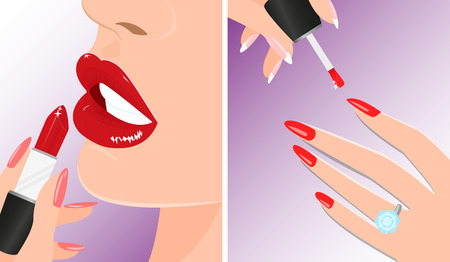Understanding the Link Between Diet and Dry Skin
When it comes to achieving healthy, glowing skin, most Americans think first about moisturizers or skincare routines. However, science reveals that what you put on your plate is just as important as what you apply on your skin. Recent research shows a strong connection between nutrition and skin hydration, highlighting how diet can either contribute to dryness or help keep your skin supple and resilient. The foods you eat provide the building blocks for your skins protective barrier, impacting everything from moisture retention to inflammation levels. By making intentional food choices—especially in a culture where processed foods and fast meals are common—you can nourish your skin from within. Understanding this link empowers you to take control of your skin health, not just with topical solutions, but with every meal.
2. Essential Nutrients for Hydrated, Healthy Skin
When it comes to managing dry skin, what you put on your plate is just as important as what you put on your skin. Americans looking for smoother, more hydrated skin should focus on incorporating specific vitamins, minerals, and healthy fats into their daily diet. These nutrients not only support skin moisture but also promote overall skin health from the inside out.
Key Nutrients for Skin Hydration
| Nutrient | Role in Skin Health | American Dietary Sources |
|---|---|---|
| Vitamin E | Protects skin cells from oxidative stress and helps retain moisture | Almonds, sunflower seeds, spinach, avocado |
| Vitamin C | Boosts collagen production and strengthens the skin barrier | Citrus fruits (oranges, grapefruits), strawberries, bell peppers |
| Omega-3 Fatty Acids | Reduces inflammation and supports skin’s lipid barrier | Salmon, walnuts, flaxseeds, chia seeds |
| Zinc | Aids in cell regeneration and repair of skin tissue | Pumpkin seeds, beef, chickpeas, cashews |
The American Approach to Balanced Nutrition
For those living in the U.S., making nutrient-rich choices often means balancing convenience with health. Busy lifestyles can lead to processed food consumption that lacks vital micronutrients. To combat dry skin, prioritize whole foods that are easy to find at local grocery stores or farmers’ markets. Consider adding a handful of nuts to your breakfast yogurt or swapping chips for veggie sticks dipped in hummus rich in zinc.
Smart Tips for Everyday Eating
- Add leafy greens and colorful vegetables to every meal for an antioxidant boost.
- Swap out processed snacks for trail mixes featuring almonds and dried fruit.
- Include fatty fish like salmon or sardines at least twice a week for omega-3s.
By focusing on these essential nutrients through accessible American dietary staples, you’ll be taking powerful steps toward softer, healthier skin—one meal at a time.

3. Best American Foods to Combat Dry Skin
When it comes to achieving smooth, hydrated skin, what you put on your plate is just as important as the products you apply. The American diet offers a variety of accessible and nutrient-rich foods that can help manage dry skin from the inside out. Below, we’ll spotlight some all-star ingredients found in many American kitchens that are packed with skin-loving benefits.
Avocados: The Creamy Superfood
Avocados are a staple in everything from toast to salads across the U.S., and for good reason. Rich in healthy fats and vitamin E, avocados nourish skin cells, helping to lock in moisture and support a natural glow. Their antioxidants also help defend against environmental stressors that contribute to dryness and premature aging.
Salmon: Omega-3 Powerhouse
Wild-caught salmon is not only delicious but also loaded with omega-3 fatty acids, which are essential for maintaining your skin’s lipid barrier. This barrier helps retain moisture and keeps irritants out—making salmon a go-to choice for those looking to combat dryness and inflammation.
Nuts: Crunchy Skin Saviors
Almonds, walnuts, and other nuts are beloved snacks throughout America. They’re bursting with vitamin E, zinc, and selenium—all key nutrients that aid in repairing damaged skin and protecting against oxidative stress. A handful of nuts each day can make a noticeable difference in the texture and resilience of your skin.
Leafy Greens: Hydration Heroes
Kale, spinach, and Swiss chard are frequent stars in salads, smoothies, and side dishes nationwide. These leafy greens are high in vitamins A and C, which promote collagen production and cell turnover for fresher, more supple skin. Their water content also contributes to overall hydration, fighting flakiness from within.
Making These Foods Part of Your Routine
The best part? Incorporating these foods into your daily diet doesn’t require fancy recipes or hard-to-find ingredients. Whether you’re whipping up a California-inspired avocado toast, grilling salmon for dinner, snacking on trail mix, or tossing together a colorful salad, these American favorites make nourishing your skin both easy and delicious.
4. What to Avoid: Common Dietary Triggers for Dry Skin
When it comes to managing dry skin, knowing what to avoid is just as crucial as adding skin-friendly foods to your diet. In the American food landscape, certain dietary choices can sabotage your efforts for a glowing complexion. Let’s break down the most common culprits—processed foods, excess sugar, and caffeine—using real-life examples you’ll easily spot in any U.S. grocery store or café.
Processed Foods: The Hidden Dangers
Highly processed foods are everywhere in America, from microwave dinners to packaged snacks like potato chips and cheese puffs. These foods are often loaded with unhealthy fats, salt, and preservatives that can contribute to inflammation and rob your skin of essential moisture. Swapping out these snacks for whole, nutrient-dense options is a simple but powerful change.
Examples & Alternatives
| Common Processed Food | Why Its Harmful | Skin-Friendly Swap |
|---|---|---|
| Pepperoni pizza rolls | High in sodium & trans fats | Whole grain pita with hummus & veggies |
| Packed cookies (e.g., Oreos) | Excess sugar, preservatives | Homemade oatmeal raisin cookies with less sugar |
| Bottled salad dressings | Added sugars & artificial flavors | Olive oil & balsamic vinegar |
Excess Sugar: Sweetness with a Cost
Sugar-laden treats are an American staple—from breakfast pastries to supersized sodas at fast-food chains. But too much sugar can disrupt collagen production and increase dryness by promoting inflammation. Instead of reaching for that glazed doughnut or 20-ounce soda, try naturally sweet options like fruit or sparkling water with fresh citrus.
Smart Substitutions:
- Instead of: Sweetened iced coffee drinks
Try: Cold brew with a splash of almond milk and cinnamon - Instead of: Candy bars
Try: Dark chocolate (70% cacao or higher) with nuts - Instead of: Flavored yogurt cups
Try: Plain Greek yogurt with berries and honey drizzle
Caffeine: Moderation Is Key
Coffee culture is huge in the U.S., but too much caffeine—found in coffee, energy drinks, and even some sodas—can dehydrate your body and skin. You don’t have to ditch your morning cup entirely; instead, balance it out with plenty of water throughout the day and consider herbal teas as a hydrating alternative.
Caffeine Consumption Guide
| Beverage/Item | Caffeine Content (approx.) | Drier Skin Risk? | Alternative Option |
|---|---|---|---|
| Larger coffee (16oz) | ~200mg | High if overconsumed | Green tea (~40mg caffeine) |
| Soda (12oz can) | ~35mg (plus sugar) | Moderate risk due to sugar/caffeine combo | Sparkling water with lemon slices |
| Energy drink (8oz) | ~80mg+ | Very high risk for dehydration & dryness | Coconut water or herbal iced tea |
Avoiding these dietary triggers—and making smart swaps—is a distinctly American challenge, but one that pays off big time in softer, more hydrated skin. By becoming mindful of what you eat and drink daily, you’re investing in your skin’s long-term health from the inside out.
5. Lifestyle Tips: Eating Habits for Everyday Hydration
Make Hydration a Daily Ritual
When it comes to managing dry skin, hydration is more than just drinking water—its about creating sustainable habits that fit the American lifestyle. Aim for at least eight cups of water a day, but don’t forget your food choices can help too! Infuse your water with lemon or cucumber for flavor, and keep a reusable bottle on hand during work, school runs, or weekend adventures.
Smart Meal Planning for Skin Health
Busy American schedules call for easy meal planning. Start by building meals around hydrating ingredients: include salads loaded with spinach, cucumbers, and tomatoes; add grilled salmon or chicken for lean protein. Opt for whole grains like brown rice or quinoa to lock in moisture and keep your energy steady throughout the day. Batch-prepping overnight oats or Greek yogurt parfaits with berries is a delicious way to start your mornings hydrated and nourished.
Snack Smarter for Better Skin
Skip processed snacks that can dehydrate your body. Instead, reach for options like apple slices with almond butter, celery sticks with hummus, or trail mix with walnuts and dried cranberries. These snacks are not only easy to pack but are also loaded with healthy fats and antioxidants that support glowing skin.
Embrace American Superfoods
Integrate locally loved superfoods into your routine. Avocados, blueberries, and sweet potatoes are widely available in the U.S. and packed with nutrients that boost hydration and repair skin cells. Try adding sliced avocado to sandwiches or tossing blueberries into smoothies for an effortless nutritional upgrade.
Create Consistency Through Routine
Staying hydrated and eating well shouldn’t feel like a chore. Make hydration fun by setting reminders on your phone or using hydration tracking apps—popular among Americans looking to meet wellness goals. Prep meals ahead of time, involve the family in cooking, and celebrate small wins as you see your skin improve. These simple lifestyle tweaks can transform everyday eating into a beauty-boosting ritual tailored for the American way of life.
6. The Role of Supplements: Should You Consider Them?
While a balanced diet is always the best foundation for healthy, hydrated skin, some Americans wonder if supplements can give them an extra edge—especially when battling persistent dry skin. In the U.S., dietary supplements like omega-3 fatty acids and vitamin E are widely available and often touted for their potential skin benefits. But before you add these to your daily routine, it’s important to understand when they might be helpful and how to use them safely.
When Might Supplements Help?
If you find that even with a nutrient-rich diet, your skin remains dry, certain supplements could fill in the gaps. Omega-3 fatty acids, commonly found in fish oil or algal oil capsules, help support your skins natural barrier and reduce inflammation. Vitamin E, known for its antioxidant properties, may also play a role in protecting skin cells from damage and improving moisture retention. These supplements are particularly useful for people who have dietary restrictions (like vegans or those with food allergies) or specific medical conditions that impact nutrient absorption.
How to Approach Supplements Safely
In the U.S., supplements aren’t regulated as strictly as prescription medications, so quality can vary between brands. To stay safe:
- Choose reputable brands with third-party testing.
- Consult with your healthcare provider or a registered dietitian before starting any new supplement—especially if you’re pregnant, nursing, or on medication.
- Stick to recommended dosages; more isn’t always better and excessive intake can cause harm.
The American Perspective: Food First, Supplements Second
American nutrition experts consistently emphasize a “food first” approach: whenever possible, get your nutrients from whole foods rather than pills or powders. Supplements should serve as a complement—not a substitute—for a healthy diet. If you think supplements could help manage your dry skin, do your homework and talk to a professional who understands both your health history and American nutrition standards. Ultimately, making informed choices will put you on the path to softer, healthier skin—inside and out.


